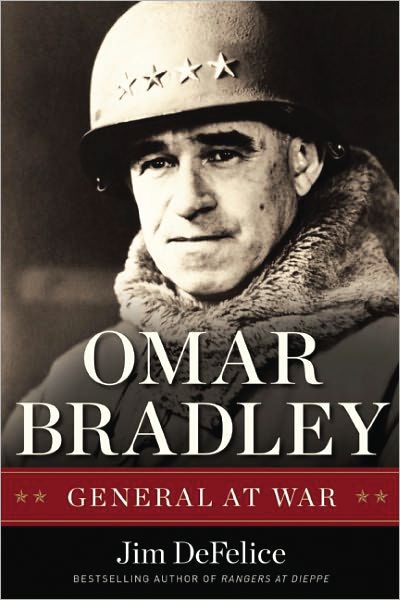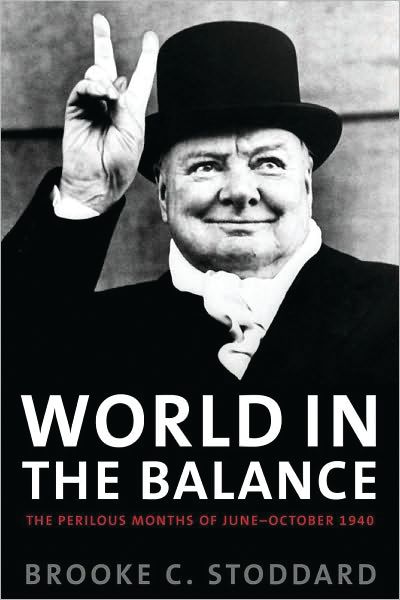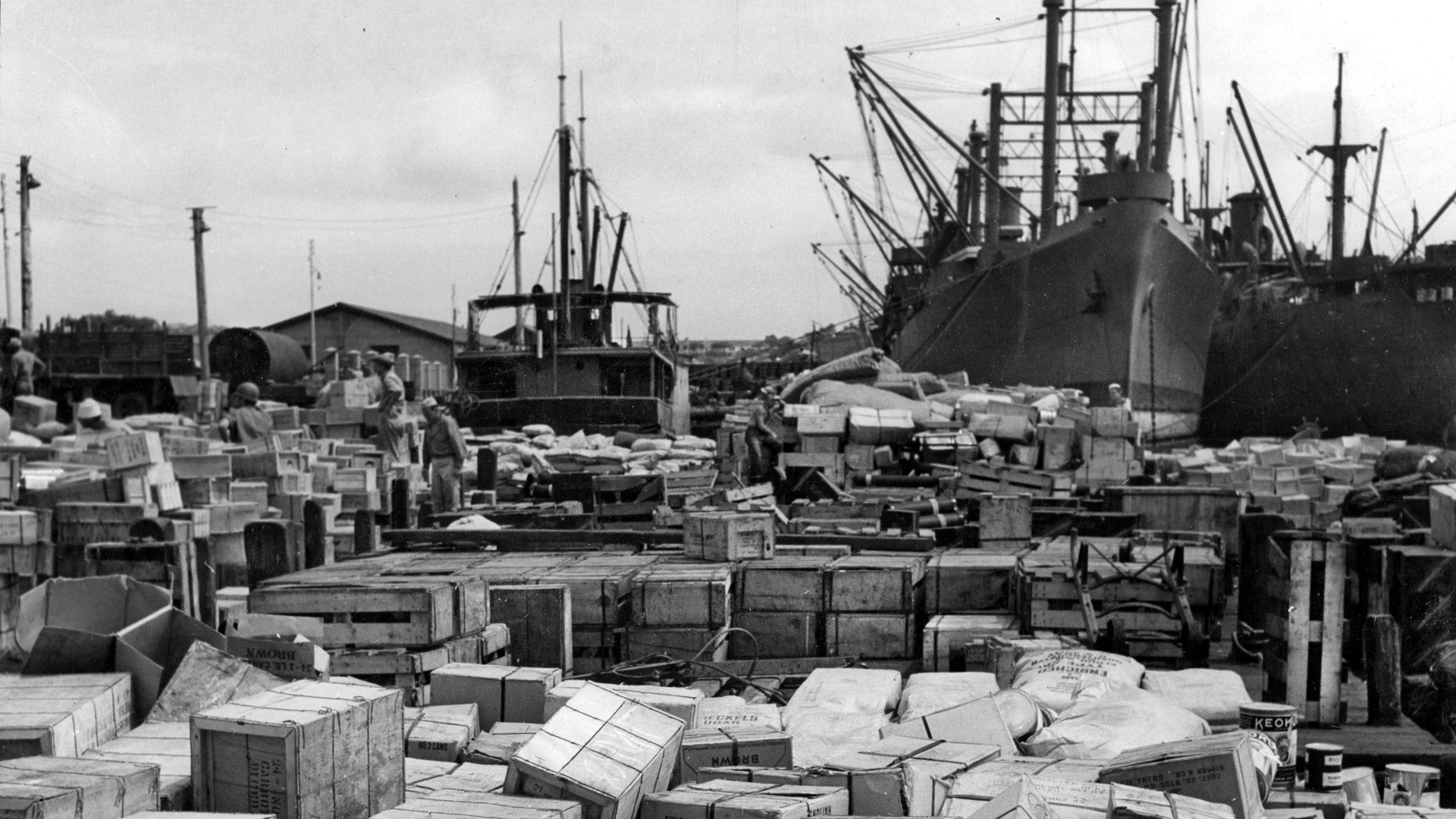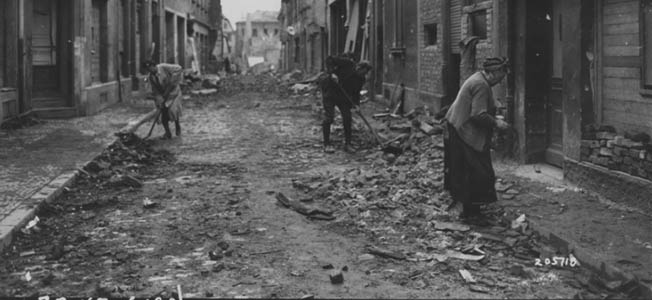As a small child growing up in Missouri, Omar Bradley was taught that honesty and hard work were virtues one should strive for in leading a decent, fulfilling life. Bringing attention to oneself by bragging about one’s own exploits was a quality that was not looked upon favorably by Bradley’s father. Years later, when he was in command of troops in North Africa and Europe, a little notoriety, ironically, may have gone a long way to enhance his personality and let the American public learn what the average GI already knew, that Bradley was a competent general who cared about his troops.

In this new biography of the U.S. Army’s last five-star general, Omar Bradley: General at War (Regnery Publishing Co., Washington, D.C., 2011, 452 pp., photos, index, notes, $29.95, hardcover), historian Jim DeFelice closely examines Bradley’s 35-year career as a soldier and his close relationship with Eisenhower, Patton, and Montgomery.
Bradley came from a humble background. His father, a local school teacher, taught the young boy how to fish and hunt. When his father died, Bradley was devastated. The young Bradley persevered because of the values deeply instilled in him by his father. He would carry this stoicism with him for the rest of his life.
Bradley was accepted and graduated from the U.S. Military Academy at West Point in 1915, 44th out of 164 cadets. The class produced 59 generals and was to become known as the “class the stars fell on.”
It was at the academy that Bradley honed his tactical skills, often called the “science of the battlefield.” Bradley joined a small cadre of cadets in an informal setting conducted by Lieutenant Forrest Harding that would reap immeasurable benefits when he was commanding large bodies of troops during World War II.
His quiet, efficient demeanor won over superiors, and he rose through the ranks quickly. He was working in General George C. Marshall’s office at Fort Benning, Georgia, prior to the war. There he was instrumental in the formation and training of the 2nd Armored Division and the 82nd Airborne Division. It was also there that Bradley got to work closely with George Patton. Although the two had vastly different personalities, the pair enjoyed a close and, for the most part, affable relationship throughout the war.
For his nearly 30 years in the Army, Bradley had yet to see actual combat. It is ironic that, as a general, he would come close to death on numerous occasions while traveling near the front as a corps and army group commander. After his superlative performance in Africa and Sicily, he was tapped by Marshall to lead an army group for the D-Day landings at Normandy.
Bradley’s no nonsense approach to combat was instrumental in revolutionizing training, coordinating the air and ground forces, and assisting in implementing the concept of integrated air power and ground assaults. His logistical planning for the Normandy landings was on a scale never before seen in war. It was a Herculean effort that proved essential in maintaining a constant flow of supplies to the troops in the field.
He played a pivotal role in the breakout from the beachheads after the D-Day landings. He was also flexible as the American Army drove deeper into France, and ultimately Germany, to the ever-changing situation that developed.
In spite of all his success, the author is quick to point out Bradley’s shortcomings. The failure of the intelligence in the Battle of the Bulge, his failure to close the Falaise Gap, and ignoring the media and not using it to his full advantage are a few of the items the author alludes to in his book.
Nevertheless, Omar Bradley was an extremely knowledgeable general who achieved success through hard work and due diligence when it came to his profession. He was, without doubt, the consummate general.
“If an army benefits from having a Patton, it truly succeeds when it has a Bradley to advise him, direct him, and supply him,” the author writes.
 Victory at Peleliu: The 81st Infantry Division’s Pacific Campaign by Bobby C. Blair and John Peter DeCioccio, University of Oklahoma Press, Norman, 2011, 310 pp., photos, maps, $34.95, hardcover.
Victory at Peleliu: The 81st Infantry Division’s Pacific Campaign by Bobby C. Blair and John Peter DeCioccio, University of Oklahoma Press, Norman, 2011, 310 pp., photos, maps, $34.95, hardcover.
At long last a book has emerged chronicling the exploits of the 81st Infantry Division in World War II. The unit, called the Wildcats, fought on Angaur and Peleliu in September-November 1944 in some of the hardest and bloodiest combat in the Pacific Theater. Much has been written about the exploits of the 1st Marine Division on Peleliu, but very little about the 81st Infantry, which performed magnificently during the operation.
On September 17, 1944, the Wildcats, minus the 323rd Regimental Combat Team (RCT), hit the beach at Angaur Island, just six miles from Peleliu. The soldiers moved rapidly until they encountered a heavily defended area in the northwest section of the island referred to as “the Bowl.” Here, the Japanese put up a dogged resistance and repulsed numerous attacks. Finally, because of lack of food and water, the enemy opposition waned. Instead of attempting to seize each cave and sustaining more casualties, the 81st Division commanders decided to seal the caves, leaving the enemy to die a slow and painful death.
Meanwhile, the 1st Marine Division and the 323rd RCT were attacking an area on Peleliu known as the Umurbrogol Pocket. It was a coral ridgeline honeycombed with caves that housed enemy artillery, machine guns, and snipers. The Japanese fended off repeated assaults by the Marines and the soldiers, and the position was soon dubbed “Bloody Nose Ridge.”
The authors illustrate the numerous contributions that the Wildcats made during the operations, such as developing creative measures in the use of sandbags and allowing them to provide protection for artillery, heavy weapons, and as barriers when crawling toward enemy fire. They manhandled pack howitzers as close to cave openings as possible to gain a better advantage. By using a pump to spray oil and igniting it with phosphorous grenades, the soldiers were able to burn the enemy from their coral sanctuaries and out into the open. The troops built a conveyor to bring supplies up the steep coral ridges and wounded back down in a quick and timely fashion.
For those readers who want to learn more about the Battles of Peleliu and Angaur from another perspective, this book is a good choice. It is a well-written account giving long overdue recognition to a fine fighting unit in World War II.
 Last of the Few: The Battle of Britain in the Words of the Pilots Who Won It by Max Arthur, Skyhorse Publishing, New York, 2011, 304 pp., index, photographs, $24.95, hardcover.
Last of the Few: The Battle of Britain in the Words of the Pilots Who Won It by Max Arthur, Skyhorse Publishing, New York, 2011, 304 pp., index, photographs, $24.95, hardcover.
“Never in the field of human conflict was so much owed by so many to so few,” Winston Churchill said when the Royal Air Force had beaten the Luftwaffe during the Battle of Britain. After the prime minister had uttered his now-famous words, the pilots and crews who had performed so magnificently during the summer and fall of 1940 would forever be known as “The Few.”
In his new book, former RAF pilot Max Arthur, a well-known oral historian in England, has spent numerous hours compiling a history of the air battle that took place in the skies over Great Britain, in the words of those who fought it.
Civilians had a ringside seat as British fighters scrambled skyward to meet the German Luftwaffe to do battle and save their island nation. In the end, the British won the day—but not without horrendous losses of their own. In addition to the more than 1,500 aircraft destroyed and the nearly 1,000 pilots killed and wounded, civilian casualties were 23,002 dead and another 32,138 wounded. On one raid alone in December 1940, almost 3,000 civilians were killed.
Despite the threat of death looming over the flight crews like an evil specter, RAF pilots answered the call as Sergeant Fred Roberts, a member of No. 19 Squadron, recalled: “We didn’t really discuss death—if a pilot were killed, it was horrible to think that half an hour before we’d been strapping him in a plane. But he’d be gone—and there’d be a replacement tomorrow. That was as far as our thoughts went. There was no such thing as stress in those days, there was no counseling or anything like that. It was an act of war—they died, they were killed.”
 The Twilight Riders: The Last Charge of the 26th Cavalry by Peter F. Stevens, Lyons Press, Guilford, CT, 2011, 290 pp., notes, index, photographs, $24.95, hardcover.
The Twilight Riders: The Last Charge of the 26th Cavalry by Peter F. Stevens, Lyons Press, Guilford, CT, 2011, 290 pp., notes, index, photographs, $24.95, hardcover.
When Japanese infantry waded ashore in the Philippine Archipelago in December 1941, General Douglas MacArthur told Lt. Gen. Jonathan Wainwright he needed to have units fight a delaying action so that the bulk of his forces could withdraw and make a stand on the Bataan Peninsula. Wainwright called upon his best troopers, the 26th Cavalry, horsemen comprised mostly of Philippine Scouts and led by white officers, to do the job.
For nearly two months, the cavalrymen fought superbly against overwhelming odds and kept the enemy off balance. On the morning of January 16, 1942, near the village of Morong, Lieutenant Edwin P. Ramsey and his troopers were ordered to stand down after a grueling two-day reconnaissance patrol. When word reached them that the Japanese had breached the center of the line, Ramsey’s men were personally ordered by Wainwright to take the advance guard.
As the horse soldiers inched their way into Morong, the enemy opened fire. Ramsey observed scores of Japanese soldiers crossing the Batolan Bridge and making their way into the village. Realizing they were still disorganized, Ramsey gave the order to charge.
Ramsey would later recall, “To them we must have seemed a vision from another century, wild-eyed horses pounding headlong; cheering, whooping men firing from saddles.”
The 26th drove the Japanese from Morong and saved the day. It was the last mounted charge in the history of the U.S. Cavalry. When Wainwright surrendered to the Japanese, some of the cavalrymen joined guerrilla forces and fought until U.S. forces liberated the Philippines in 1944. The horsemen suffered 301 killed and countless wounded during the campaign. If it were not for their heroic stand, the enemy would have seized the Philippines much sooner. As Wainwright wrote in his official report: “This devoted little band of horsemen had maintained the best traditions of the American Cavalry.”
 Normandy Crucible: The Decisive Battle That Shaped World War II in Europe by John Prados, NAL Caliber, New York, 2011, 336 pp., notes, index, $25.95, hardcover.
Normandy Crucible: The Decisive Battle That Shaped World War II in Europe by John Prados, NAL Caliber, New York, 2011, 336 pp., notes, index, $25.95, hardcover.
Noted military historian John Prados, intrigued by the Normandy invasion, offers a fresh look at the campaign that he believes shaped the outcome of World War II. Prados closely examines how the Allies gained a foothold on the beaches but were stopped when German resistance stiffened. This prompted him to examine intelligence reports, official records, and other data to gain a better insight into why and how the enemy could rebound so quickly after such a stunning defeat at the beachheads.
With the American Army’s breakout at St. Lo and the British advance on Caen, it appeared that the Allies were once again on the move and the downfall of Germany would proceed at a quicker pace. However, with the stunning offensive in the Ardennes, known as the Battle of the Bulge, the Germans once again hastily reorganized and smashed the Allied line.
Prados’s narrative not only gives the reader the big picture of the strategies employed by the commanders in the field, but also personal accounts from those intimately involved in the fighting.
Once again, Prados does a bang-up job and offers new data on a period of World War II that has been well researched and written about for more than 60 years.
 Pacific Air: How Fearless Flyboys, Peerless Aircraft, and Fast Flattops Conquered the Skies in the War with Japan by David Sears, Da Capo Press, Cambridge, MA, 2011, 372 pp., index, notes, photographs, $27.50, hardcover.
Pacific Air: How Fearless Flyboys, Peerless Aircraft, and Fast Flattops Conquered the Skies in the War with Japan by David Sears, Da Capo Press, Cambridge, MA, 2011, 372 pp., index, notes, photographs, $27.50, hardcover.
The author, a Vietnam veteran and naval officer, has written an excellent book focusing on the exploits of World War II pilots whose innovative approach to aerial combat helped the United States gain air supremacy that eventually defeated the Japanese Empire.
In the early days of the Pacific War, American planes were no match for the quick and nimble Mitsubishi Zero fighter. The plane, piloted by experienced Japanese aviators, dominated the skies. Gradually, as the Grumman Corporation’s F4F Wildcat and F6F Hellcat fighters and TBF Avenger torpedo bomber and the rugged Vought F4U Corsair fighter appeared on the scene, the tide began to turn.
Navy pilots such as David McCampbell, Edward “Butch” O’Hare, and John Thach made a difference in the air war through their ground-breaking tactics that would result in more than 5,000 enemy aircraft being destroyed, an incredible 19-to-1 ratio, and aiding in winning the pivotal Battle of the Philippine Sea.
Sears’s account is a tribute to the men who pioneered the aerial tactics that enabled the Navy and Marine aviators to beat the Japanese at their own game—and achieve victory.
 Churchill’s War Lab: Code-breakers, Boffins and Innovators: The Mavericks Churchill Led to Victory by Taylor Downing, Overlook Press, New York, 2011, 416 pp., index, notes, photographs, $30.00, hardcover.
Churchill’s War Lab: Code-breakers, Boffins and Innovators: The Mavericks Churchill Led to Victory by Taylor Downing, Overlook Press, New York, 2011, 416 pp., index, notes, photographs, $30.00, hardcover.
It takes much more than armies, logistics, and leadership to win battles and, ultimately, wars. A good, solid intelligence system and innovative thinkers that can devise new and improved weaponry, radar, and other war-related equipment are also essential.
No one knew this better than Winston Churchill. And during World War II the ubiquitous British prime minister, who had his hands in nearly every aspect of England’s war machine, assembled some of the top scientists, code breakers, and analysts to combat the Nazi threat.
One of the most unusual members of this odd mix was Professor Frederick Lindemann, a renowned physicist, who had hobnobbed with Albert Einstein prior to the war while visiting Berlin. Although crass and insensitive in social surroundings, this absent-minded professor developed a method for pilots to come out of a tailspin during World War I.
Lindemann also had the uncanny ability to summarize most technical or scientific matters very quickly so even a layman could understand them. This proved invaluable to Churchill, who was never a math wizard, so he could read Lindemann’s brief synopsis on an issue and quickly comprehend it.
Downing has written an interesting account of another lesser-known facet of World War II. He gives us a wonderful glimpse into Churchill’s inner war room and the characters who occupied it. But, with all their idiosyncrasies and quirks, this unlikely group helped end the conflict and achieve victory for the Allied cause.
 MacArthur: America’s General by Mitchell Yockelson, Thomas Nelson Books, Nashville, TN, 2011, 224 pp., notes, index, $19.99, hardcover.
MacArthur: America’s General by Mitchell Yockelson, Thomas Nelson Books, Nashville, TN, 2011, 224 pp., notes, index, $19.99, hardcover.
Yockelson examines the life of arguably America’s most famous and controversial general and his more than 50 years of service to his country. As the author states, MacArthur’s life and experiences were not without flaws, especially during the 1932 Bonus Army march in Washington, D.C., when he ordered the burning of ramshackle houses built by World War I veterans who had descended upon the nation’s capital to demand the bonus that had been promised to them after the war.
Egotistical and arrogant, MacArthur butted heads with presidents, the most famous encounter being with Harry Truman during the Korean War in which Truman finally axed him. On another occasion, MacArthur got into a heated debate over the Army budget with Franklin Delano Roosevelt and made some disparaging remarks to the president. Roosevelt admonished him, but when he offered to resign, FDR calmly told him that they both had to set aside their differences and work together.
This is a gem of a book that delivers new information on the charismatic General Douglas MacArthur.
Short Bursts
 World in Balance: The Perilous Months of June-October 1940 by Brooke C. Stoddard, Potomac Books, Washington, D.C., 2011, 256 pp., notes, index, photographs, hardcover.
World in Balance: The Perilous Months of June-October 1940 by Brooke C. Stoddard, Potomac Books, Washington, D.C., 2011, 256 pp., notes, index, photographs, hardcover.
The year 1940 was not a very good one for the Allies. France fell, the British made a hasty retreat from Dunkirk to avoid annihilation and capture, and Belgium, Norway, Poland, Denmark, plus other countries, had fallen under the control of the Nazi boot.
Only the island nation of Great Britain remained to be taken and Hitler had plans to do just that—by bombing them into submission and then invading. The British government had no one to turn to for assistance (although the United States had not entered the war, it was providing war material through the Lend-Lease Act) and had to face Hitler’s hordes alone.
And face the Nazis they did. Inspired by the words of their cigar-smoking, defiant Prime Minister Winston Churchill, the English stood steadfast and finally beat the tyrannical despot’s air force during those frightening and uncertain months of the Battle of Britain in 1940.
 101st Airborne: The Screaming Eagles at Normandy by Mark Bando, Quayside Publishing, Minneapolis, MN, 2011, 156 pp., index, photographs, $29.99, softcover.
101st Airborne: The Screaming Eagles at Normandy by Mark Bando, Quayside Publishing, Minneapolis, MN, 2011, 156 pp., index, photographs, $29.99, softcover.
Enough cannot be written about the heroic exploits of the “Screaming Eagles” and their outstanding performance during the Normandy invasion on June 6, 1944. This book is chock full of photos, some color and from private collections, that have never before been seen.
Bando traces the combat of the 101st Airborne from D-Day to war’s end. There are even chapters devoted to the 82nd Airborne and another relating the story of the real Private Ryan, Frederick “Fritz” Niland, who lost three of his brothers during the time he jumped into Normandy. His account was used by Steven Spielberg in his 1998 movie Saving Private Ryan.
 32 in ’44: Building the Portsmouth Submarine Fleet in World War II by Rodney K. Watterson, Naval Institute Press, Annapolis, MD, 2011, 172 pp., index, notes, photographs, $34.95, hardcover.
32 in ’44: Building the Portsmouth Submarine Fleet in World War II by Rodney K. Watterson, Naval Institute Press, Annapolis, MD, 2011, 172 pp., index, notes, photographs, $34.95, hardcover.
After the Japanese sneak attack on Pearl Harbor in December 1941, America mobilized for war. One of the items that the U.S. was in short supply of was submarines. Shipbuilding companies across the nation went all-out to increase their production, and one of the top manufacturers during that period was the Portsmouth Naval Shipyard in New Hampshire, which launched a record four submarines on January 27, 1944.
Prior to the war, Portsmouth had been producing just two subs a year and employing about 2,000 workers. Those numbers would increase dramatically during the ensuing years, with a record 32 vessels being launched by a highly motivated group of more than 20,000 employees.
The author highlights the professionalism of these workers, and the pioneering approach that management undertook to accomplish these record-setting achievements.
 Bombs Away! The World War II Bombing Campaigns over Europe by John R. Bruning, Zenith Press, Minneapolis, MN, 2011, 292 pp., index, notes, photographs, maps, $50.00, hardcover.
Bombs Away! The World War II Bombing Campaigns over Europe by John R. Bruning, Zenith Press, Minneapolis, MN, 2011, 292 pp., index, notes, photographs, maps, $50.00, hardcover.
This coffee table-size book covers the six-year strategic bombing campaign over Europe by Allied forces and early German offensive efforts during the Battle of Britain. The author begins with the evolution of the bomber aircraft from both the Allies and the German perspective. By implementing a plan of attack that included not only air, but sea and land warfare as well, the Allies were finally able to achieve victory.
The book has some great photographs, some in color, that have never before been published. There are maps included to give the reader a better insight into the bombing campaign. A map of Great Britain depicting the Royal Air Force and German Luftwaffe units deployed during the Battle of Britain is very detailed and a wonderful addition to the book.
 The National D-Day Memorial: Evolution of an Idea by Byron Dickson, Dickson Architects, Roanoke, VA, 2011, 104 pp., $24.95, softcover.
The National D-Day Memorial: Evolution of an Idea by Byron Dickson, Dickson Architects, Roanoke, VA, 2011, 104 pp., $24.95, softcover.
Byron Dickson, the Roanoke architect who assisted in designing the D-Day Memorial, located in Bedford, Virginia, has given a superb account of the planning, design, construction, and dedication of the monument that was built as a tribute to those who stormed ashore on the five beaches on that fateful day in June 1944.
The massive 88-acre site is dominated by the 44-foot-high Overlord Arch that commemorates the where, what, and when of the monumental event. The grounds are dotted with gardens, sculptures, gazebos, and an “invasion pool” depicting a soldier, holding his M-1 Garand rifle over his head, attempting to make it safely ashore.
The book is filled with numerous photographs illustrating the construction phase, and artist’s sketches used as models for the project. Nestled near the Blue Ridge Mountains, the memorial is a fitting tribute to those who participated in D-Day, especially the soldiers who gave their lives to free Europe from the grip of fascism.









Join The Conversation
Comments
View All Comments